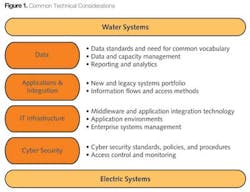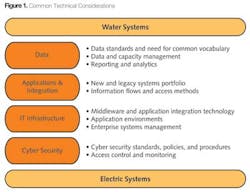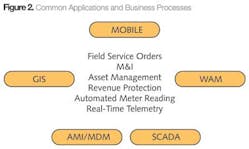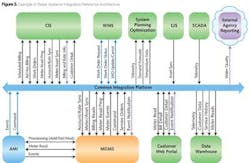By Joe Tellez
Advances in system integration architecture, standards and technology aren't just for electric. Water services also share similar information management and business process automation needs as their electric counterparts. Although Smart Grid integration architecture approaches are predominantly geared toward electric utilities, investments in application integration technology, data standards and IT infrastructure management can directly benefit municipal utilities that also provide water services.
What about Water?
Water services departments are sometimes absent in the new Smart Grid IT technology planning that is focused on electric systems. They are often left in their own silo while technical staff focuses on electric projects. Yet, water services face a similar set of challenges with the need to reduce operating costs, improve service delivery, increase revenue protection, incorporate new sources of information to improve system operations, and optimize information sharing between departments. Further, water departments often find themselves on the short end of the technology investment stick as compared to their electric counterparts. Water utilities are often faced with deeper cuts to operating budgets. These cuts can be an unintended consequence of reduced revenue due to successful water conservation programs, especially in areas where the availability of the water supply is continually constrained.
Water service departments can also incorporate automated metering, event management, work and asset management, and other related distribution management functions that share many similarities with their electric counterparts. Rather than deploying costly one-off systems integration solutions and applications, water can leverage a common utility architecture that reduces the amount of customization needed to integrate water systems and provide for:
- The secure and reliable exchange of information over a standards-based enterprise integration platform
- A common representation of information which extends available industry data standards
- The use of shared infrastructure that optimizes the return on investment in smart grid technology in municipal utilities that offer both electric and water services
- A more robust business process automation framework for meter to cash, revenue protection, and workforce and asset management functions
Synergies and Intersections between Water and Electric Systems
Utility operations systems perform very similar business functions but are often implemented as separate systems for water and electric services. There are some differences between these systems, such as the nature of information used in the business processes, the volume of data and the variety of data sources. For example, automated read intervals for water meters are often performed hourly versus every fifteen minutes for electric. Also AMI data can be used for automated leak detection in water as compared to tamper/theft detection for electric. However, the underlying applications technologies are essentially the same. The utility applications and business process functions shown in Figure 2 are present in both electric and water operations.
Rather than implementing redundant systems for each, a common system architecture that leverages available integration and data standards can help municipal utilities gain operational synergies between departments and reduce overall IT systems integration costs.
Water Systems Architecture
A systems integration architecture such as the one depicted in Figure 3 is essentially a plan representing operational systems, key information exchange flows between each system and identification of the common data elements required to support the business transactions. Characteristics of best practice utility integration architectures are those that leverage standards and common infrastructure such as:
Standards-based information exchange models are being applied to electric data for transmission and distribution management systems yielding consistent representation of common data objects in disparate systems. Water data can easily map to some of the standard models used for electric. For example, an asset will have standard descriptors for name, device type, locations, etc. — it should not matter if the asset is a wire or a pipe. Also, standard identifiers for service orders will have the same customer, location and order types for both electric and water service requests. The benefits of employing standard data models go beyond just increasing interoperability between various operational systems (which are often from different vendors). A common data vocabulary ultimately can result in fewer system interfaces to be developed and maintained. A service order message can be reused for both water and electric requests even if from different systems.
When it comes to building the interfaces that handle the data exchange between systems, a common implementation method for water applications is what is commonly referred to as point-to-point integration. This method often requires rather complex mapping and programming of interface logic between two different systems. Since water applications come in a variety of packages with varying interoperability capability, this method of interfacing systems can yield to costly implementations and require a higher maintenance footprint by the IT programming staff.
The adoption of an application integration layer that provides for the ability to create interfaces and integrate disparate systems using interoperability standards is considered a mature, best practice for electric systems integration that water systems can easily adopt. The use of a common integration platform to integrate systems can yield:
- Implementation consistency to avoid one-off solutions
- Utilization of a common data vocabulary to increase information sharing
- Reduced vendor 'lock-in' from complex, proprietary interfaces
- Reduced number of interfaces that need to be developed and maintained
These benefits translate into lower implementation and support costs associated with introducing new operations systems.
New Capability and Opportunities
The benefits of this approach go well beyond the technical gains in systems integration. The increased interoperability between systems, the access to real-time measurement data in operational decision-making, and the ability to detect and manage operational events are the new value propositions presented to water operations. From the interoperability perspective, the ability to interact with multiple external agencies for water quality reporting and status of storage supplies is significantly enhanced and can provide for more timely and accurate data reporting. By leveraging the event management capabilities of best of breed integration layer technologies, water operations can automate manual leak detection processes and better leverage system telemetry for operational planning. On the consumer side, increased data access can result in new service offerings that provide customers insight into their water usage and help them manage consumption alongside electric demand-side management programs.
Conclusion
Municipal water utilities can enhance the interoperability of their systems portfolio and reduce IT costs for integrating applications. There is significant opportunity to leverage standard systems integration and implementation methods currently being used by electric utilities. Water and electric applications that automate similar business processes may be consolidated and deployed for use by both departments, especially in the areas of work and asset management.
To capitalize on these opportunities, water systems project managers, analysts, architects, and operations managers need a pragmatic approach to enterprise system integration. New knowledge and capability will also be required from the IT staff.
Water services should look for any new approaches and technologies already being deployed as part of Smart Grid. From an enterprise view, the integration architecture should not differentiate between electrons and molecules.
About the Author:Joe Tellez is a Vice President at UISOL. He has 18 years of experience in the water, gas, and electric utilities industry, and specializes in integration architectures for advanced metering/Smart Grid, distribution planning, maintenance and inspection, customer services and billing, and field force automation. His background includes operations planning for large-scale water distribution and storage systems. Joe holds a B.S. in Industrial and Systems Engineering and M.S. in Systems Architecture and Engineering and is a TOGAF certified IT Architect. He can be reached via email at [email protected].
More WaterWorld Current Issue Articles
More WaterWorld Archives Issue Articles






